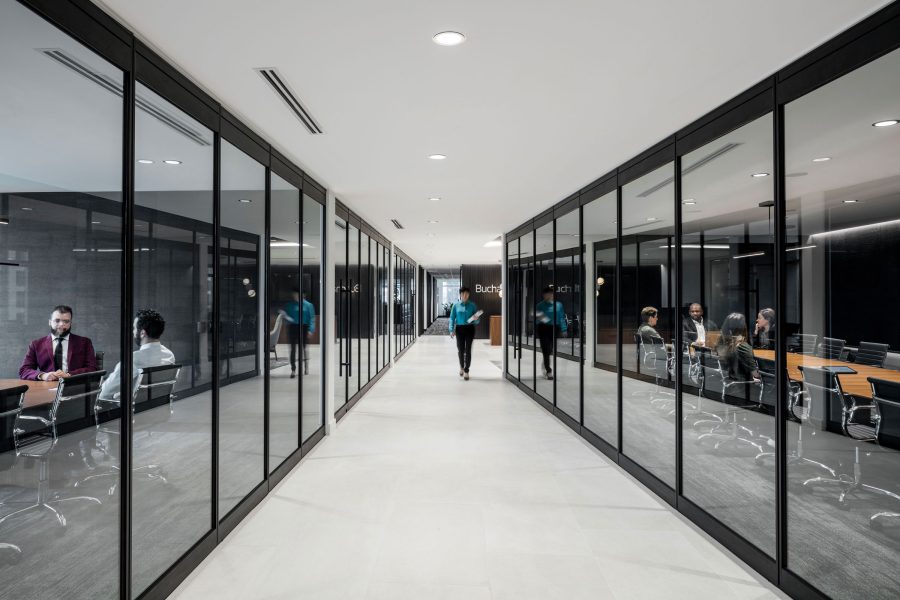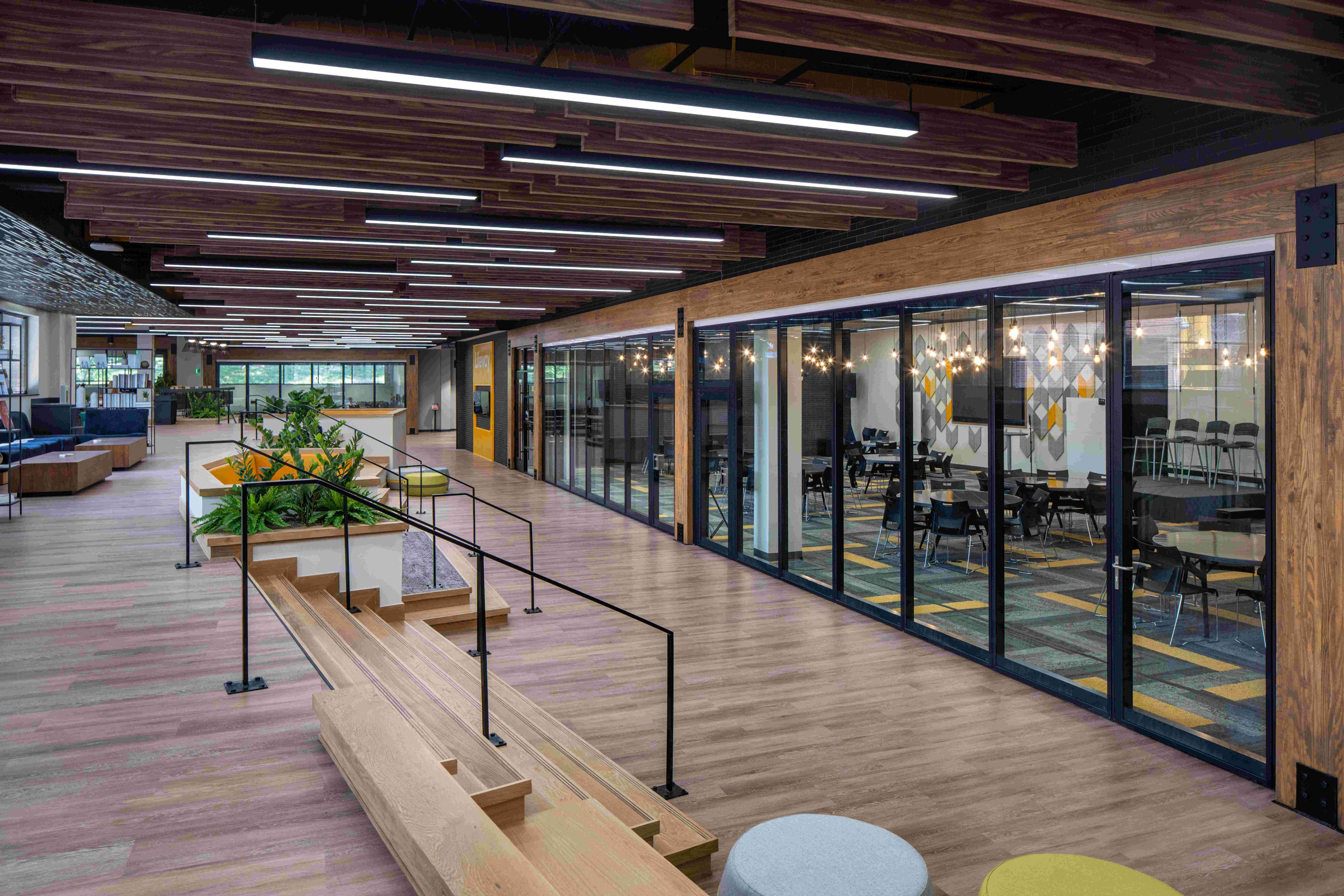Story at a glance:
- The increase in remote work has led to significant changes in office design.
- Employers are focused on the flexibility of their space, as well as comfort and privacy.
- Movable wall solutions help address these challenges and draw workers back to the office.
Designers and their clients are employing a number of unique strategies and tools to address the changing dynamics in contemporary office design in the “work-from-wherever” era. Bryan Welch, president of Modernfold—a leader in movable wall partitions—agrees that flexibility and adaptability are critical in today’s office market.
“I feel like flexibility is becoming more and more of an expectation, rather than an add-on, from an office design standpoint,” Welch says. “We make operable partitions, but what we are really selling is flexible space.”
Movable partitions can facilitate a more adaptable work environment by giving tenants the freedom to quickly reconfigure their spaces to meet their needs at any given time. And while architects once viewed movable walls simply as utilitarian tools to address this particular need, recent innovations in the market have resulted in a wide array of products that can create both beautiful and functional spaces.
Flexibility is becoming more and more of an expectation.
“If an organization can evolve conference spaces into amenity spaces or flex the number of workstations they need month-to-month, then they are inherently more ready for the future,” says Peter McCarthy, principal and commercial leader at CannonDesign, a top architecture firm with nearly 1,300 employees across 18 offices.
Yet encouraging employees to return to the office requires more than building out an adaptable space. At a time when office footprints are shrinking and the same number of employees are expected to productively share a smaller space, privacy and comfort are factoring into design decisions more than ever.
“The office needs to be a space that feels good to go to. It has to be a productive environment; you have to feel efficient, like you’re getting something done,” Welch says. “You made the commute, and when you get there it needs to be some place that you want to be and accomplish something that you would have difficulty doing remotely.”
Designing Flexible Spaces

National law firm Buchalter renovated their Portland office entrance and conference space with Modernfold’s PureView Plus movable glass wall system. Photo courtesy of Modernfold
As hybrid work becomes the new normal and companies large and small adjust their spaces accordingly, movable walls have moved up on architects’ radars as a necessary feature of their designs.
When Lifeway, a nonprofit provider of ministry resources based in Nashville, set out to create a new home for their hybrid workforce, the space needed to be flexible and adaptable to accommodate private workstations, small team meeting rooms, multimedia production spaces, and gathering areas for up to 300 people to host produced launches and larger events.
To accomplish this, the design team worked with Modernfold to incorporate the firm’s Acousti-Clear® Glass Wall Systems into the concept. In a space that would serve a diverse array of uses and needs, Acousti-Clear’s combination of sleek, modern aesthetics and high acoustical control made it the ideal solution.
The 4-inch dual paned glass wall system was customized with a satin black powder coat frame to match the frontage window design of the building, and its 51 STC rating—a measure of the number of decibels of sound it can block out—meant that the operations in the organization’s video, podcast, and photography studios would not disturb employees who needed a quiet place to work.
“The Lifeway project addresses the return-to-work revamps that are quite common these days as companies look to maximize their footprint with a partially remote workforce and simultaneously create an inviting space that employees want to go into the office to enjoy,” Welch says.
The Importance of Comfort and Privacy

Inside national law firm Buchalter’s renovated Portland office. Photo courtesy of Modernfold
As office footprints shrink employee comfort and privacy are more important than ever, as crowded open spaces cause distractions that lower overall productivity.
Even when separated by a partition, a series of adjacent meeting rooms will not provide comfortable, productive spaces for their occupants if acoustical control has not been considered in the design phase.
That’s why Acousti-Clear has been engineered with a higher STC rating than traditional glass wall partitions. “I can’t give away the exact secret sauce, but our engineers were able to find the right formula that allows it to stop more sound without adding to the weight of it or making the panels thicker,” Welch says.
Form and Functionality
The comfort of a workspace extends beyond acoustics, and hybrid workers have become accustomed to the health and wellness benefits of natural daylight. That’s one of the reasons glass walls have become increasingly popular in interior design, as they allow everyone in a workplace to experience daylight—not simply the executives with corner offices.
“More and more there’s pressure to open office spaces up on the interior and push light deeper and deeper into the building, and our glass wall portfolio can help with that,” Welch says.
This was a key consideration when national law firm Buchalter began renovating portions of its Portland office, including the conference spaces. The firm’s office offers sweeping views of the Portland skyline, and the goal was to ensure these views could make their way into the entirety of their space.
Buchalter engaged Modernfold to explore solutions that would maximize views and daylight while also offering sound control for their conference rooms. The firm landed on Modernfold’s Pureview® Plus horizontal rail system, which features a slimmer, single-paned glass system that employees can easily operate themselves with a 37 STC rating, and was able to create a bright, transparent space with appropriate acoustical control.
“What are architects looking for today? They want a product that integrates well with their design,” Welch says. “They want something that is as simple as possible, looks good when it’s deployed, and fills the needs of the space.”
Sustainable Design Goals
Movable partitions like Modernfold’s suite of products can also be used to achieve sustainability goals and support LEED points for energy as well as indoor air quality. Offering health product declarations (HPDs), environmental product declarations (EPDs), environmental impact reports, California Department of Public Health certifications, and GBCI-certified continuing education, Modernfold is focused on being the sustainability partner in the operable wall market. “Sustainability continues to be more and more important with decision makers,” Welch says. “What’s considered a highly sustainable product today might be average in the next few years.”
Movable walls help facilitate zoned HVAC systems by partitioning off unused sections of the office, where the HVAC system can be shut off until the space is used. “This helps lower your CO2 load because now you have a smaller space to heat or cool more efficiently,” Welch says.
The daylight that glass walls bring into a space further reduces energy use for lighting and provides occupants with greater access and visibility to a natural, outdoor environment, improving overall occupant well-being.
Looking Toward the Future
Few can predict with certainty what the future of offices will look like, but according to Welch, technological features like automation will only continue to grow in popularity.
“What we see is that automation is the way of the future. If you go back and look at car windows, manual operation was standard and automation costs extra. Today customers expect automation to be the standard,” he says.
Modernfold’s ComfortDrive® offering is an automated self-driving panel system that allows its glass panels to be moved to pre-programmed positions with the touch of a button. The system works on programmable trolleys with a home position, a deployed position, and two additional custom configurations.
This feature ensures consistency while removing the need for workers to manually move partitions between meetings. This is especially beneficial in spaces that turn over multiple times each day for different needs.
“Automation is going to support that need for flexibility because the space is going to be transformed so quickly,” Welch says.


